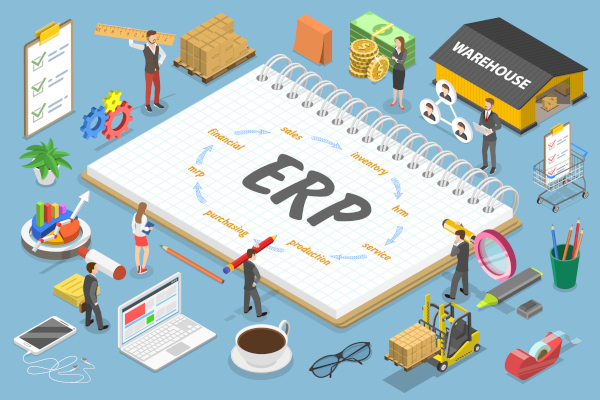In the modern landscape, enterprise resource planning (ERP) systems play an essential role in day-to-day business operations. The foundation of the ERP is transactional data - orders, shipments, claims, invoices. The ERP system is often shown at the center of the suite of supply chain systems, e.g., warehouse management (WMS), transportation management (TMS), and electronic data interchange (EDI). Designing an ERP is a lengthy process that involves all departments working together for an extensive period of time, and even if everything is done right, the end product might still not offer a truly holistic view of the organization.
Typically, one of the departments (sales, finance, customer service, supply chain, manufacturing) will have a larger say in terms of how the system is ultimately configured. Do we prioritize ease of financial reporting or the accuracy of depicting every node in the value chain? The answer is never explicit, but it will drive the ERP configuration.
It is important to understand the role of the ERP system within an enterprise. Yes, the ERP system does financial reporting, but ERP systems have grown beyond being (just) “accounting” systems: they are the core supply chain data and transaction sources of truth. The ERP system supports – no, enables - the supply chain operations of the company to happen. Without these operations occurring, there is nothing to account for. As such, the priority of the ERP system should be to support the supply chain functions while ensuring that everything taking place is well accounted for. It is a balance, but one that is not necessarily perfectly equally weighted.
Performing in silos
It is likely that the end product will be siloed by poor supply chain network design, in most cases. This leads to a situation where every business function will be tempted to perform the analysis using only their set of transactional data. For example, the finance team might suggest discontinuing a certain product because of its low margins. They would not know that the sales of that product drive the sales of others, much more profitable ones. There are other similar cases out there - the manufacturing of this seemingly problematic product could require the production line to undergo more extensive or frequent maintenance.
Just looking at the transactional data generated by the ERP, it can be very difficult to make network-wide strategic optimization decisions. In an ERP system, the rebates that the company gets from purchasing a certain volume from a supplier are not translated into the units of finished goods produced and shipped from a given manufacturing plant. The warehouse storage space costs are not directly linked to every pallet that was moved in and out of there. Business leaders need to make sure all pieces are tied together in order to understand what can be optimized.
Tying it together
This is where supply chain network design comes into play - tying all the nodes, going beyond the transactional data to educate the stakeholders and equip them to make the right end-to-end decisions. Buying less from a more expensive supplier might seem a good idea unless we look at the full picture of where the business gets an end-of-year volume-based rebate that actually makes that supplier the cheapest in the mix.
In consumer product companies selling into retail via B2B or B2C, accounting departments should be discerning and recording supply chain deductions such as those for co-op marketing differently from and separately from vendor compliance chargebacks which are financial penalties for not conforming to customer (retailer) technical and operational supply chain mandates. Chargeback data should be shared by the accounting department with other departments such as information technology, operations, supply chain, warehousing, distribution, logistics, and sales order processing. By taking a supply chain network perspective, chargeback root cause analysis and remediation are more effective.
Supply chain network design fills the critical gaps left by ERPs, providing the tools and insights required for holistic, agile, and optimized supply chain operations. By integrating supply chain network design with the ERP systems, businesses can leverage the best of both worlds, positioning themselves for success in a competitive and unpredictable marketplace.
But to be effective, supply chain network design requires participants to prioritize the enterprise before egos: there can be no place for personal pride or politics when the health of the organization is actually at stake and is critical to the survival of the enterprise and ultimately everyone’s benefit. In a commoditized world, execution is the new competitive edge. Good supply chain network design helps to ensure that enterprises are performing properly at each stage of their supply chain with respect to the supply chain as an end-to-end whole.
About the authors:
Marianna Vydrevich is a supply chain network design expert and is manager of operations research & network optimization for GAF, North America’s largest roofing manufacturer.
Norman Katz is president of Katzscan Inc. (www.katzscan.com) a supply chain technology and operations consultancy that specializes in vendor compliance, ERP, EDI, and barcode applications. He is the author of “Detecting and Reducing Supply Chain Fraud” (Gower/Routledge, 2012), “Successful Supply Chain Vendor Compliance” (Gower/Routledge, 2016), and “Attack, Parry, Riposte: A Fencer’s Guide To Better Business Execution” (Austin Macauley, 2020). Katz is a U.S. national and international speaker and article writer, and a foil and saber fencer and fencing instructor.
SC
MR


Latest Supply Chain News
Latest Resources

 Explore
Explore
Topics
Business Management News
- Unlocking retention: The role employee engagement plays
- Can supply chain managers embrace an entrepreneurial mindset?
- Challenges to ESG reporting
- With capacity to spare, logistics real estate demand remains subdued
- How to improve demand forecasts for new product families
- Services sector sees growth in October, reports ISM
- More Business Management
Latest Business Management Resources

Subscribe

Supply Chain Management Review delivers the best industry content.

Editors’ Picks




